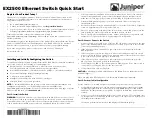
DGS-3700 Series Layer 2 Managed Gigabit Ethernet Switch CLI Reference Guide
Page | 258
M
ULTIPLE
S
PANNING
T
REE
P
ROTOCOL
(MSTP)
C
OMMANDS
Back to Section Header
This Switch supports three versions of the Spanning Tree Protocol: 802.1D-2004 STP-compatible, 802.1D-
2004 Rapid STP and 802.1Q-2005 MSTP. Multiple Spanning Tree Protocol, or MSTP, is a standard defined
by the IEEE community that allows multiple VLANs to be mapped to a single spanning tree instance, which
will provide multiple pathways across the network. Therefore, these MSTP configurations will balance the
traffic load, preventing wide scale disruptions when a single spanning tree instance fails. This will allow for
faster convergences of new topologies for the failed instance. Frames designated for these VLANs will be
processed quickly and completely throughout interconnected bridges utilizing either of the three spanning
tree protocols (STP, RSTP or MSTP). This protocol will also tag BDPU packets so receiving devices can
distinguish spanning tree instances, spanning tree regions and the VLANs associated with them. These
instances will be classified by an
instance_id
. MSTP will connect multiple spanning trees with a Common
and Internal Spanning Tree (CIST). The CIST will automatically determine each MSTP region, its maximum
possible extent and will appear as one virtual bridge that runs a single spanning tree. Consequentially,
frames assigned to different VLANs will follow different data routes within administratively established
regions on the network, continuing to allow simple and full processing of frames, regardless of
administrative errors in defining VLANs and their respective spanning trees.
Each switch utilizing the MSTP on a network will have a single MSTP configuration that will have the
following three attributes:
a)
A configuration name defined by an alphanumeric string of up to 32 characters (defined in
the config
stp mst_config_id
command as
name <string>
).
b)
A configuration revision number (named here as a
revision_level
) and;
c)
A 4096 element table (defined here as a
vid_range
) which will associate each of the possible 4096
VLANs supported by the Switch for a given instance.
To utilize the MSTP function on the Switch, three steps need to be taken:
a)
The Switch must be set to the MSTP setting (
config stp version
)
b)
The correct spanning tree priority for the MSTP instance must be entered (
config stp priority
).
c)
VLANs that will be shared must be added to the MSTP Instance ID (
config stp instance_id
).
The Multiple Spanning Tree Protocol commands in the Command Line Interface (CLI) are listed (along with
the appropriate parameters) in the following table.
C
OMMAND
P
ARAMETERS
enable stp
disable stp
config stp version
[mstp | rstp | stp]
config stp
{maxage <value 6-40> | maxhops <value 6-40> | hellotime <value 1-2> |
forwarddelay <value 4-30>| txholdcount <value 1-10> | fbpdu [enable |
disable] |nni_bpdu_addr [dot1d | dot1ad]}
config stp ports
<portlist> {externalCost [ auto | <value 1-200000000>] | hellotime <value 1-
2> | migrate [yes | no] | edge [true | false | auto] | p2p [true | false | auto] |
state [enable | disable] | restricted_role [true | false] | restricted_tcn [true |
false] | fbpdu [enable | disable]}
create stp instance_id
<value 1-15>
config stp instance_id
<value 1-15> [add_vlan | remove_vlan] <vidlist>
delete stp instance_id
<value 1-15>
config stp priority
<value 0-61440> instance_id <value 0-15>
















































